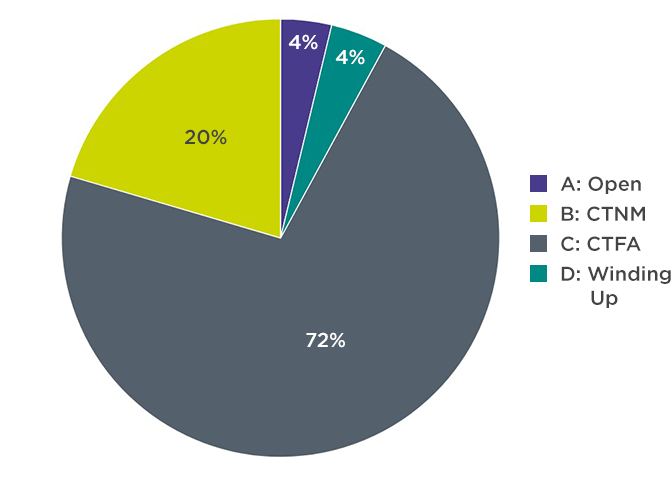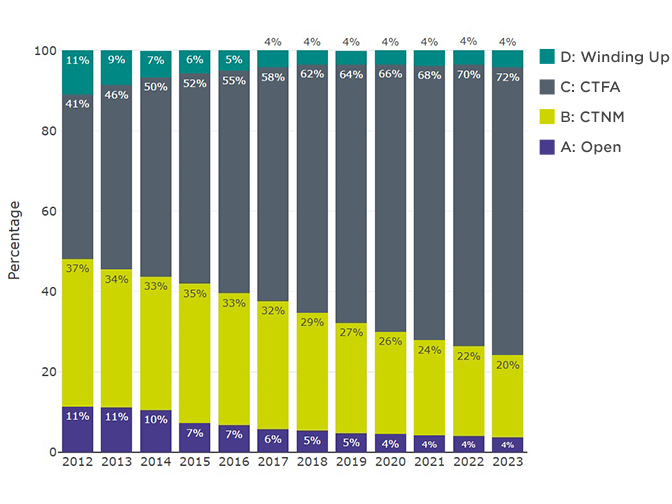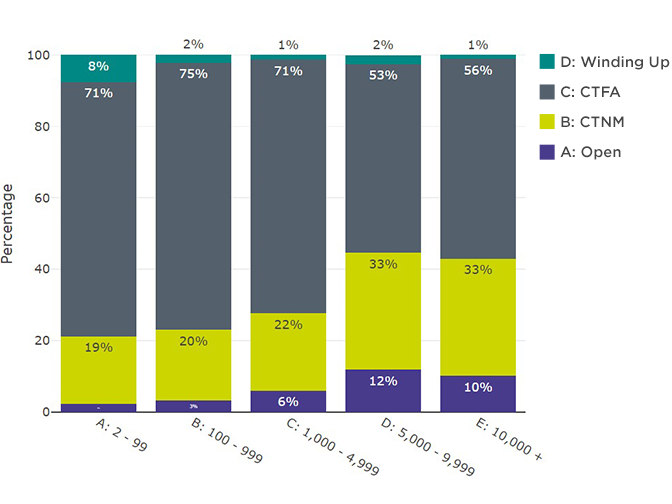This is an official statistics publication produced by The Pensions Regulator (TPR). This annual publication provides an overview of the occupational defined benefit (DB) and hybrid scheme landscape in the UK, reporting on scheme status, membership levels and assets under management.
Published: 20 February 2024
Important changes since last year
For the 2023 release of this publication, the methodology for validating scheme status for private DB and hybrid schemes has been enhanced to validate the data submitted to us via the scheme return. These substantive revisions change the status attributed to individual schemes impacting 1,534 schemes. As such, status data should not be compared to previous publications of the DB landscape, or to The Purple Book 2023 published by the Pension Protection Fund (PPF). The new validation method has been consistently applied to all time series data within this publication. For more details about the validation methodology please see the methodology section of this publication.
Key findings
- As with previous years, the DB and hybrid landscape continues to shrink at a consistent rate. Since 2022 the total number of schemes has reduced by 2% from 5,378 to 5,297. For schemes within the landscape, the percentage closed to future accrual (excluding those in wind-up) has risen from 70% to 72%.
- Scheme funding levels have improved since 2022, with the number of schemes with 100% or greater technical provisions funding levels increased from 2,565 to 3,620. The total deficit (of schemes in deficit) has more than halved, reducing from £63.610 billion to £27.673 billion.
Private schemes by status
Scheme status describes the position of a scheme’s lifecycle from starting up to final closure. The statuses in this release are split between:
- open schemes, where new members can join the DB section of the scheme and accrue benefits
- schemes closed to new members (CTNM), in which existing members can continue to accrue benefits but no new members can join
- schemes closed to future accruals (CTFA), where existing members can no longer accrue new years of service and no new members can join
- schemes that are in the process of winding up
Figure 1: Distribution of schemes by status
Figure 1 data: Data underlying Figure 1, pertaining to the distribution of schemes by status
| Status | Number of Schemes |
|---|---|
| A: Open | 199 |
| B: CTNM | 1,083 |
| C: CTFA | 3,794 |
| D: Winding up | 221 |
Table 1: Scheme status by year
| Status | 2012 | 2013 | 2014 | 2015 | 2016 | 2017 | 2018 | 2019 | 2020 | 2021 | 2022 | 2023 |
|---|---|---|---|---|---|---|---|---|---|---|---|---|
| A: Open | 11% | 11% | 11% | 7% | 7% | 6% | 5% | 5% | 5% | 4% | 4% | 4% |
| B: CTNM | 37% | 34% | 33% | 35% | 33% | 32% | 29% | 27% | 25% | 24% | 22% | 20% |
| C: CTFA | 41% | 46% | 50% | 52% | 55% | 58% | 62% | 64% | 67% | 68% | 70% | 72% |
| D: Winding up | 11% | 9% | 7% | 6% | 5% | 4% | 4% | 3% | 3% | 4% | 4% | 4% |
| Total | 100% | 100% | 100% | 100% | 100% | 100% | 100% | 100% | 100% | 100% | 100% | 100% |
| Number of schemes | 7,297 | 6,974 | 6,657 | 6,396 | 6,206 | 5,973 | 5,805 | 5,701 | 5,604 | 5,522 | 5,378 | 5,297 |
Table 2: Scheme status by year excluding schemes offering both DB and DC benefits
| Status | 2012 | 2013 | 2014 | 2015 | 2016 | 2017 | 2018 | 2019 | 2020 | 2021 | 2022 | 2023 |
|---|---|---|---|---|---|---|---|---|---|---|---|---|
| A:Open | 13% | 13% | 12% | 8% | 7% | 6% | 5% | 5% | 5% | 4% | 4% | 4% |
| B: CTNM | 37% | 34% | 34% | 36% | 34% | 33% | 31% | 28% | 26% | 25% | 23% | 21% |
| C: CTFA | 38% | 44% | 48% | 50% | 54% | 56% | 60% | 63% | 65% | 67% | 69% | 71% |
| Winding up | 12% | 9% | 7% | 6% | 5% | 5% | 4% | 4% | 4% | 4% | 4% | 5% |
| Total | 100% | 100% | 100% | 100% | 100% | 100% | 100% | 100% | 100% | 100% | 100% | 100% |
Figure 2: Distribution of schemes by status and year
Figure 2 data: Data underlying Figure 2, pertaining to the distribution of schemes by status and year
| Status | Year | Percentage |
|---|---|---|
| A: Open | 2012 | 11% |
| A: Open | 2013 | 11% |
| A: Open | 2014 | 10% |
| A: Open | 2015 | 7% |
| A: Open | 2016 | 7% |
| A: Open | 2017 | 6% |
| A: Open | 2018 | 5% |
| A: Open | 2019 | 5% |
| A: Open | 2020 | 4% |
| A: Open | 2021 | 4% |
| A: Open | 2022 | 4% |
| A: Open | 2023 | 4% |
| B: CTNM | 2012 | 37% |
| B: CTNM | 2013 | 34% |
| B: CTNM | 2014 | 33% |
| B: CTNM | 2015 | 35% |
| B: CTNM | 2016 | 33% |
| B: CTNM | 2017 | 32% |
| B: CTNM | 2018 | 29% |
| B: CTNM | 2019 | 27% |
| B: CTNM | 2020 | 26% |
| B: CTNM | 2021 | 24% |
| B: CTNM | 2022 | 22% |
| B: CTNM | 2023 | 20% |
| C: CTFA | 2012 | 41% |
| C: CTFA | 2013 | 46% |
| C: CTFA | 2014 | 50% |
| C: CTFA | 2015 | 52% |
| C: CTFA | 2016 | 55% |
| C: CTFA | 2017 | 58% |
| C: CTFA | 2018 | 62% |
| C: CTFA | 2019 | 64% |
| C: CTFA | 2020 | 66% |
| C: CTFA | 2021 | 68% |
| C: CTFA | 2022 | 70% |
| C: CTFA | 2023 | 72% |
| D: Winding up | 2012 | 11% |
| D: Winding up | 2013 | 9% |
| D: Winding up | 2014 | 7% |
| D: Winding up | 2015 | 6% |
| D: Winding up | 2016 | 5% |
| D: Winding up | 2017 | 4% |
| D: Winding up | 2018 | 4% |
| D: Winding up | 2019 | 4% |
| D: Winding up | 2020 | 4% |
| D: Winding up | 2021 | 4% |
| D: Winding up | 2022 | 4% |
| D: Winding up | 2023 | 4% |
Figure 3: Distribution of schemes by status and membership group
Figure 3 data: Data underlying Figure 3, pertaining to the distribution of schemes by status and membership group
| Status | Member Group | Percentage |
|---|---|---|
| A: Open | A: 2 - 99 | 2% |
| A: Open | B: 100 - 999 | 3% |
| A: Open | C: 1,000 - 4,999 | 6% |
| A: Open | D: 5,000 - 9,999 | 12% |
| A: Open | E: 10,000 + | 10% |
| B: CTNM | A: 2 - 99 | 19% |
| B: CTNM | B: 100 - 999 | 20% |
| B: CTNM | C: 1,000 - 4,999 | 22% |
| B: CTNM | D: 5,000 - 9,999 | 33% |
| B: CTNM | E: 10,000 + | 33% |
| C: CTFA | A: 2 - 99 | 71% |
| C: CTFA | B: 100 - 999 | 75% |
| C: CTFA | C: 1,000 - 4,999 | 71% |
| C: CTFA | D: 5,000 - 9,999 | 53% |
| C: CTFA | E: 10,000 + | 56% |
| D: Winding up | A: 2 - 99 | 8% |
| D: Winding up | B: 100 - 999 | 2% |
| D: Winding up | C: 1,000 - 4,999 | 1% |
| D: Winding up | D: 5,000 - 9,999 | 3% |
| D: Winding up | E: 10,000 + | 1% |
Private scheme membership by status
Figure 4: Distribution of memberships by status
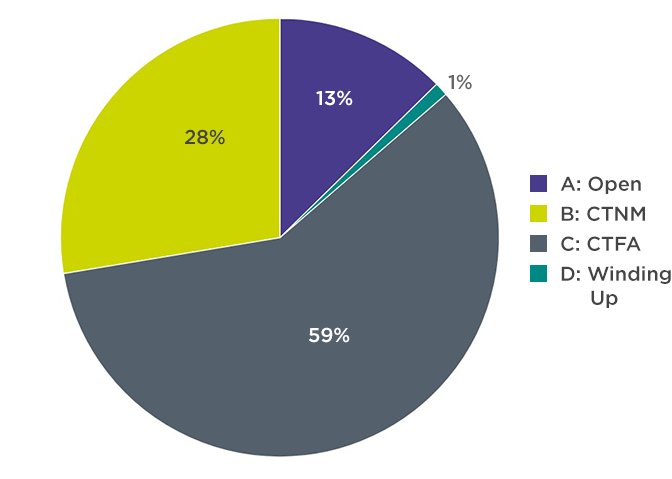
Figure 4 data: Data underlying Figure 4, pertaining to the distribution of memberships by status
| Status | Number of memberships | Percentage of memberships |
|---|---|---|
| A: Open | 1,217,076 | 13% |
| B: CTNM | 2,654,349 | 28% |
| C: CTFA | 5,644,196 | 59% |
| D: Winding up | 95,668 | 1% |
Table 3: Distribution of memberships by status and year
| Status | 2012 | 2013 | 2014 | 2015 | 2016 | 2017 | 2018 | 2019 | 2020 | 2021 | 2022 | 2023 |
|---|---|---|---|---|---|---|---|---|---|---|---|---|
| A: Open | 22% | 20% | 19% | 17% | 15% | 13% | 14% | 13% | 15% | 15% | 14% | 13% |
| B: CTNM | 51% | 44% | 44% | 42% | 44% | 41% | 37% | 34% | 32% | 29% | 28% | 28% |
| C: CTFA | 26% | 34% | 36% | 40% | 39% | 45% | 48% | 52% | 52% | 54% | 57% | 59% |
| D: Winding up | 2% | 2% | 2% | 1% | 2% | 1% | 1% | 1% | 1% | 1% | 1% | 1% |
| Total | 100% | 100% | 100% | 100% | 100% | 100% | 100% | 100% | 100% | 100% | 100% | 100% |
Table 4: Number of memberships by status and membership type
| Status | Active | Deferred | Pensioner |
|---|---|---|---|
| A: Open | 444,332 | 452,468 | 320,276 |
| B: CTNM | 238,415 | 1,037,656 | 1,378,278 |
| C: CTFA | 0 | 3,103,802 | 2,540,394 |
| D: Winding up | 0 | 39,417 | 56,251 |
| Total | 682,747 | 4,633,343 | 4,295,199 |
Membership by size
Table 5: Number of memberships by membership group and membership type
| Membership group | Active | Deferred | Pensioner |
|---|---|---|---|
| A: 2 - 99 | 2,876 | 36,083 | 45,776 |
| B: 100 - 999 | 26,947 | 384,487 | 374,407 |
| C: 1,000 - 4,999 | 76,479 | 766,863 | 698,463 |
| D: 5,000 - 9,999 | 80,005 | 507,930 | 530,226 |
| E: 10,000 + | 496,440 | 2,937,980 | 2,646,327 |
| Total | 682,747 | 4,633,343 | 4,295,199 |
Membership by year
Figure 5: Memberships by type and year
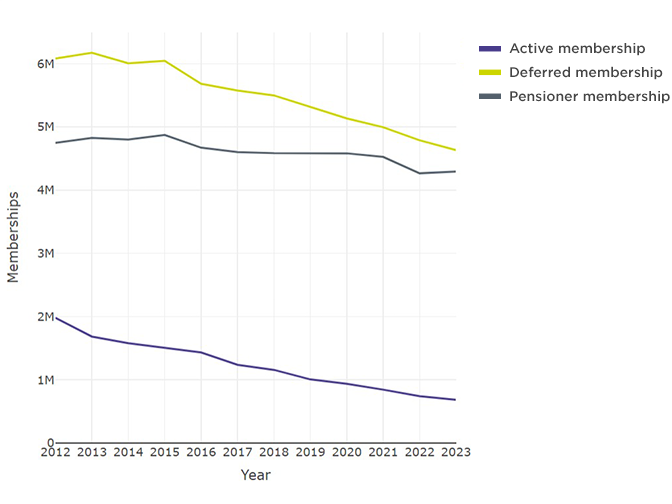
Figure 5 data: Data underlying Figure 5, pertaining to memberships by type and year
| Year | Active memberships | Deferred memberships | Pensioner memberships |
|---|---|---|---|
| 2012 | 1,979,586 | 6,081,992 | 4,747,805 |
| 2013 | 1,684,337 | 6,173,836 | 4,826,893 |
| 2014 | 1,579,519 | 6,006,134 | 4,799,853 |
| 2015 | 1,511,430 | 6,045,276 | 4,872,638 |
| 2016 | 1,433,021 | 5,682,218 | 4,671,850 |
| 2017 | 1,237,045 | 5,575,378 | 4,603,368 |
| 2018 | 1,157,394 | 5,498,234 | 4,585,165 |
| 2019 | 1,006,442 | 5,316,616 | 4,588,475 |
| 2020 | 937,544 | 5,134,377 | 4,582,563 |
| 2021 | 844,360 | 4,994,743 | 4,526,214 |
| 2022 | 740,808 | 4,788,751 | 4,266,879 |
| 2023 | 682,747 | 4,633,343 | 4,295,199 |
Schemes and memberships by principal employer type
Table 6: Proportion of schemes by status and principal employer type (% by status)
| Principal employer type | A: Open | B: CTNM | C: CTFA | D: Winding up | Total |
|---|---|---|---|---|---|
| College or education institution | 30% | 28% | 38% | 4% | 100% |
| Government / public body | 9% | 0% | 91% | 0% | 100% |
| Limited liability partnership | 0% | 3% | 97% | 0% | 100% |
| Other | 10% | 22% | 65% | 3% | 100% |
| Overseas Company | 0% | 18% | 78% | 5% | 100% |
| Partnership | 0% | 6% | 90% | 3% | 100% |
| Private limited company | 1% | 18% | 78% | 3% | 100% |
| Public limited company | 1% | 22% | 74% | 3% | 100% |
| Registered charity | 4% | 19% | 75% | 3% | 100% |
| Sole trader | 0% | 33% | 67% | 0% | 100% |
Table 7: Proportion of memberships by status and principal employer type (% by status)
| Principal employer type | A: Open | B: CTNM | C: CTFA | D: Winding up | Total |
|---|---|---|---|---|---|
| College or education institution | 75% | 16% | 8% | 0% | 100% |
| Government / public body | 0% | 0% | 100% | 0% | 100% |
| Limited liability partnership | 0% | 1% | 99% | 0% | 100% |
| Other | 18% | 28% | 53% | 1% | 100% |
| Overseas Company | 0% | 18% | 79% | 2% | 100% |
| Partnership | 0% | 33% | 66% | 0% | 100% |
| Private limited company | 17% | 25% | 57% | 1% | 100% |
| Public limited company | 1% | 32% | 66% | 1% | 100% |
| Registered charity | 24% | 14% | 62% | 0% | 100% |
| Sole trader | 0% | 6% | 94% | 0% | 100% |
Table 8: Proportion of schemes by principal employer type and status (% by employer type)
| Principal employer type | A: Open | B: CTNM | C: CTFA | D: Winding up |
|---|---|---|---|---|
| College or education institution | 14% | 2% | 1% | 2% |
| Government / public body | 1% | 0% | 0% | 0% |
| Limited liability partnership | 0% | 0% | 2% | 0% |
| Other | 37% | 12% | 9% | 10% |
| Overseas Company | 0% | 1% | 1% | 2% |
| Partnership | 0% | 0% | 1% | 1% |
| Private limited company | 37% | 69% | 73% | 71% |
| Public limited company | 4% | 10% | 8% | 9% |
| Registered charity | 8% | 6% | 6% | 5% |
| Sole trader | 0% | 0% | 0% | 0% |
| Total | 100% | 100% | 100% | 100% |
Table 9: Proportion of memberships by principal employer type and status (% by employer type)
| Principal employer type | A: Open | B: CTNM | C: CTFA | D: Winding up |
|---|---|---|---|---|
| College or education institution | 15% | 2% | 0% | 0% |
| Government / public body | 0% | 0% | 1% | 0% |
| Limited liability partnership | 0% | 0% | 1% | 0% |
| Other | 9% | 7% | 6% | 6% |
| Overseas Company | 0% | 0% | 0% | 1% |
| Partnership | 0% | 0% | 0% | 0% |
| Private limited company | 69% | 49% | 51% | 66% |
| Public limited company | 3% | 41% | 38% | 26% |
| Registered charity | 4% | 1% | 2% | 1% |
| Sole trader | 0% | 0% | 0% | 0% |
| Total | 100% | 100% | 100% | 100% |
Technical provisions funding position
Figure 6: Estimated technical provisions funding figures as at 31 March 2023 for schemes in surplus and deficit by scheme status (excludes schemes winding up)
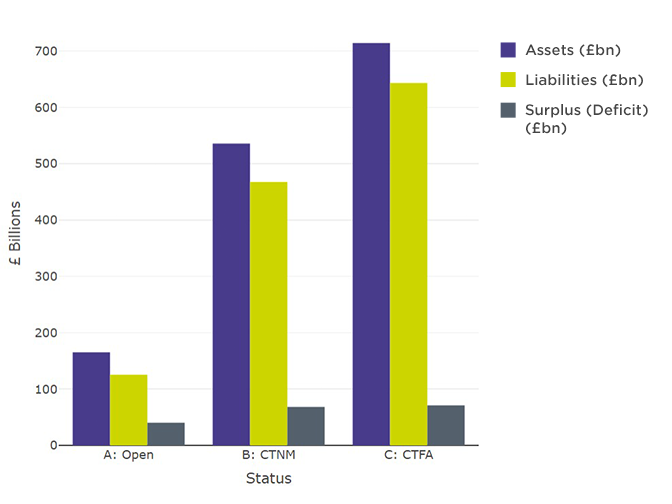
Figure 6 data: Data underlying Figure 6, pertaining to technical provisions funding figures by scheme status
| Status | Assets (£bn) | Technical provisions liabilities (£bn) | Surplus (Deficit) (£bn) |
|---|---|---|---|
| A: Open | 165.260 | 125.198 | 40.061 |
| B: CTNM | 535.806 | 467.538 | 68.268 |
| C: CTFA | 714.437 | 643.452 | 70.985 |
Table 10: Estimated funding figures as at 31 March 2023 for schemes in deficit by status (excludes schemes winding up) with a comparison to overall total for 31 March 2022
| Status | Assets (£bn) | Technical provisions liabilities (£bn) | Surplus (Deficit) (£bn) |
|---|---|---|---|
| A: Open | 2.093 | 2.253 | -0.160 |
| B: CTNM | 103.823 | 112.962 | -9.140 |
| C: CTFA | 182.866 | 201.240 | -18.373 |
| Total | 288.782 | 316.455 | -27.673 |
| Total (2022) | 770.186 | 832.796 | -62.610 |
Table 11: Estimated funding figures as at 31 March 2023 for schemes in surplus by status (excludes schemes winding up) with a comparison to overall total for 31 March 2022
| Status | Assets (£bn) | Technical provisions liabilities (£bn) | Surplus (Deficit) (£bn) |
|---|---|---|---|
| A: Open | 163.166 | 122.945 | 40.221 |
| B: CTNM | 431.984 | 354.576 | 77.408 |
| C: CTFA | 531.571 | 442.213 | 89.358 |
| Total | 1,126.721 | 919.734 | 206.988 |
| Total (2022) | 1,037.856 | 957.671 | 80.184 |
Table 12: Number of schemes by estimated funding level as at 31 March 2023 and status (excludes schemes winding up) with a comparison to overall total for 31 March 2022
** - count suppressed. Any counts less than 5 are suppressed.
| Status | Less than 60% | 60% to less than 80% | 80% to less than 100% | 100% or greater |
|---|---|---|---|---|
| A: Open | ** | 17 | 176 | |
| B: CTNM | ** | 17 | 162 | 892 |
| C: CTFA | 35 | 190 | 941 | 2,552 |
| Total | 35 | 207 | 1,120 | 3,620 |
| Total (2022) | 85 | 437 | 2,036 | 2,565 |
Figure 7: Estimated technical provisions funding figures as at 31 March 2023 by membership group (excludes schemes winding up)
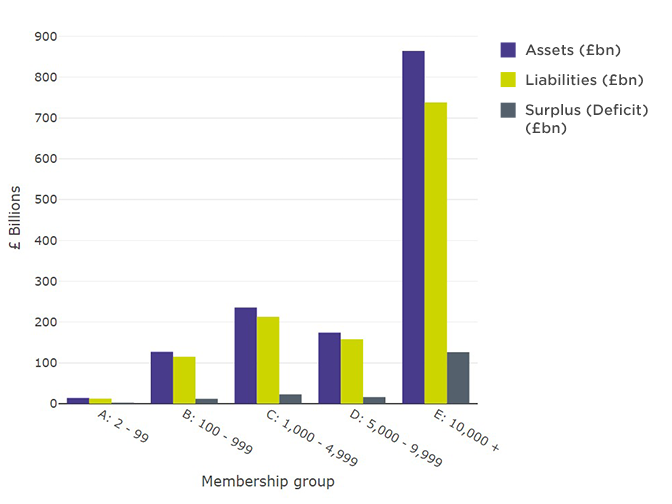
Figure 7 data: Data underlying Figure 7, pertaining to technical provisions funding figures by membership group
| Membership group | Assets (£bn) | Technical provisions liabilities (£bn) | Surplus (Deficit) (£bn) |
|---|---|---|---|
| A: 2 - 99 | 14.061 | 12.550 | 1.511 |
| B: 100 - 999 | 127.119 | 115.129 | 11.990 |
| C: 1,000 - 4,999 | 235.739 | 212.838 | 22.901 |
| D: 5,000 - 9,999 | 174.137 | 157.746 | 16.391 |
| E: 10,000 + | 864.447 | 737.925 | 126.522 |
Table 13: Number of schemes by membership group and estimated funding level group (by technical provisions) as at 31 March 2023 (excludes schemes winding up) with a comparison to overall total for 31 March 2022
** - count suppressed. Any counts less than 5 are suppressed.
| Membership group | Less than 60% | 60% to less than 80% | 80% to less than 100% | 100% or greater |
|---|---|---|---|---|
| A: 2 - 99 | 12 | 84 | 353 | 1,380 |
| B: 100 - 999 | 22 | 93 | 496 | 1,562 |
| C: 1,000 - 4,999 | ** | 27 | 177 | 456 |
| D: 5,000 - 9,999 | ** | ** | 52 | 96 |
| E: 10,000 + | ** | ** | 42 | 126 |
| Total | 34 | 204 | 1,120 | 3,620 |
| Total (2022) | 84 | 437 | 2,036 | 2,565 |
Public service defined benefit schemes
Figure 8: Balance of membership types in public service schemes
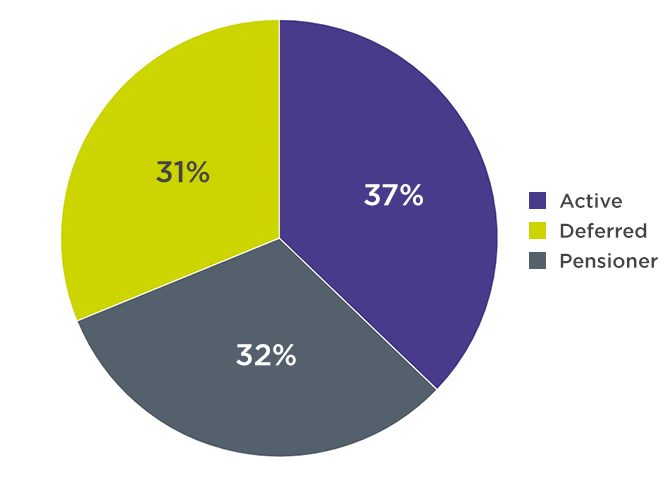
Figure 8 data: Data underlying Figure 8, pertaining to the balance of membership types in public service schemes
| Membership type | Memberships |
|---|---|
| Active | 7,163,318 |
| Deferred | 6,007,176 |
| Pensioner | 6,096,291 |
Figure 9: Comparison of balance of membership types – public service and private DB/hybrid
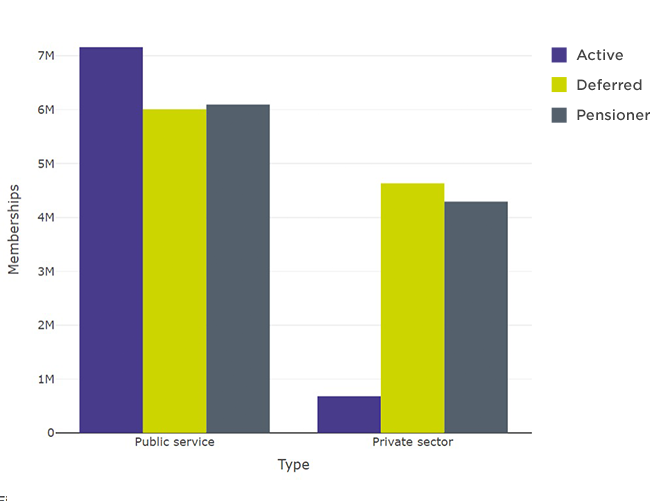
Figure 9 data: Data underlying Figure 9, pertaining to the balance of membership types in public service schemes
| Type | Active | Deferred | Pensioner |
|---|---|---|---|
| Public service | 7,163,318 | 6,007,176 | 6,096,291 |
| Private sector | 682,747 | 4,633,343 | 4,295,199 |
Using this publication
Data sources
The data used to produce our official statistics is collected from all occupational DB and hybrid schemes, via our DB and hybrid scheme returns. This publication uses data held by us as at 31 March 2023. Schemes are required to submit their returns by 31 March annually.
For membership statistics the data relates to the scheme’s effective date, which falls between the 2021/2022 financial year.
For the funding figures, this has been adjusted to a common date 31 March 23 (see methodology section for more details).
The scheme return includes private and public service DB and hybrid schemes.
Private schemes in scope have more than one member that are eligible for the (PPF) and/or are subject to the Pensions Act 2004 Part 3 ('technical provisions') funding regime as of 31 March 2023 and/or are in the process of winding up. There are 5,297 private schemes in scope.
There are 21 public service pension schemes in scope. We treat each of the locally administered sections as a separate scheme and therefore regard the public service landscape as having 204 schemes.
Statistics for 'technical provisions funding' only covers 94% of the entire private scheme population. Schemes excluded are not required to submit technical provisions funding valuations as they meet one of the following criteria:
- they are in the process of winding up
- they are not yet liable to submit a technical provisions valuation
- data required for funding calculations is missing
This publication is not directly comparable with the PPF’s Purple Book which includes only those schemes eligible for the PPF.
Please note that individuals may have multiple pension entitlements spread over multiple schemes, so they may be included more than once in 'membership' counts.
Methodology
These statistics report on administrative data, and accuracy is addressed by eliminating data errors as far as possible. Potential sources of error include:
- schemes entering data incorrectly as part of their scheme return
- mistakes in the programming code used to analyse the data and produce the statistics, and by analysts interpreting the data incorrectly
Throughout this publication we have rounded percentage figures to 0 decimal places, and the sum may not equate to exactly 100% in all instances for this reason. Financial figures have been rounded to the nearest £million.
Technical provisions funding position
The funding figures in this publication represent estimated assets and technical provisions liabilities of private sector occupational DB schemes, rolled forward from their most recent actuarial valuation to a common date of 31 March 2023.
An actuarial or funding valuation is a calculation made by an actuary of the assets needed for the scheme to meet its statutory funding objective. These include pensions in payment (including those payable to survivors of former members) and benefits accrued by other members and beneficiaries, which will become payable in the future.
Our actuarial team has estimated changes in the amount of liabilities for individual schemes between their latest valuation date (as reported by the trustees in their scheme return or recovery plan submission) and a common date using an internal model. This is done by tracking changes in fixed interest and index-linked gilt yields and, before the COVID-19 pandemic, by tracking the results from the annual Continuous Mortality Investigation (CMI) mortality projections analysis.
Due to the impact of COVID-19, we have not made further adjustments on how this might affect the trustees’ mortality assumptions in respect of experience in 2020 or 2021 and have only adjusted for 25% of experience in 2022. It measures the corresponding changes in asset positions by tracking the performance of the relevant indices (based on the asset allocations as reported by the trustees in their scheme return).
The model tracks the effect of changed market conditions between these two dates on a consistent basis for all schemes. This basis is reviewed regularly. It does not consider any other changes to a scheme’s asset and liability profile due to scheme experience, benefit changes, post valuation benefit accrual, demographic changes, curtailments, settlements, changes in asset strategy, scheme specific investment performance, contingent assets, or covenant support. In particular, the change in liability driven investment values over 2022 may not be fully recognised in the model.
Scheme status data validation
There are four ordered validation steps applied to private sector DB and hybrid scheme statuses.
- Step 1: for mixed hybrid schemes that have identified that they will not accept new members who would accrue a defined benefit entitlement, we have adjusted the status to 'closed to new members'.
- Step 2: where a scheme states they are 'open' or 'closed to new members' but have both no active DB members and no active liabilities, the status is adjusted to 'closed to future accruals'.
- Step 3: where a scheme states they are 'closed to future accrual' but have both active DB members and active liabilities, the status is adjusted to 'closed to new members'.
- Step 4: where a scheme states they are 'open' but have had declining total membership over the previous three years, the status is adjusted to 'closed to new members'.
In all other cases, statuses are taken to be as submitted by the scheme. 1,534 schemes have had their status changed as part of the validation methodology.
For schemes that are classified as closed to future accrual, any memberships classified as 'active' have been reclassified as 'deferred'. This impacts 72,945 memberships.
Changes in 2023
We have enhanced our methodology for validating scheme status for private DB and hybrid schemes in 2023 as part of a programme of continuous improvement around digital and data. This is to mitigate administrative error and improve the accuracy of the statistics reported in our publication.
For 2023, we have added steps 2, 3 and 4 to the scheme status data validation method detailed above. In previous years only the first of the four steps was applied. All other data validation methods have remained constant.
As scheme status is a key segmentation category in this our publication, this has led to substantial changes in our 2023 DB and hybrid schemes annual landscape official statistics. However, these changes better reflect the ever-changing DB landscape.
Since the 2022 publication, the following has happened.
- The number of schemes in closed to future accrual has risen from 50% to 72%. It is estimated that 91% of the change is driven by the methodological improvements and 9% is driven by changes to scheme status since 2022*.
- While the methodology reclassifying active members in closed to future accrual schemes as deferred has not changed, it now impacts more schemes. The number of active members has decreased from 741,000 (to three significant figures) to 683,000 (to three significant figures), an 8% reduction.
- It is estimated that 62% of the change is driven by methodological improvements and 38% is driven by changes to the active members since 2022.
* the rise of number of schemes in closed to future accrual was incorrectly stated on 20 February 2024. This point has since been revised.
Contact
If you have a specific enquiry about our DB and hybrid schemes 2023 Official Statistics, please contact: TPRSurveys@tpr.gov.uk
Glossary
Accrual
Accrual is the build-up of an active scheme member’s pension benefits or entitlements in a DB pension scheme.
Active members
In a DB scheme, these are members of the scheme who are current employees and accruing benefits.
Actuarial or funding valuation
A comparison by the actuary of the value placed on scheme assets with the technical provisions and an assessment of any future contribution requirement. Calculating the technical provisions is usually based on full member-by-member data.
Closed to future accrual
Where existing members can no longer accrue new years of service and no new members can join.
Closed to new members
Schemes in which existing members continue to accrue benefits but no new members can join.
Deferred members
Deferred members are members of pension schemes who have accrued rights to pensions that will come into payment in the future but who are no longer accruing benefits in the scheme. Also known as members with preserved pension entitlements.
Defined benefit (DB)
A defined benefit (DB) pension is one in which the rules of the scheme specify the rate of benefits to be paid. The most common DB scheme is a final salary scheme in which the benefits are based on the number of years of pensionable service, the accrual rate and the final salary. An alternative to the final salary scheme is the Career Average Revalued Earnings (CARE) scheme, which is also a DB scheme.
Effective date (valuation date)
An actuarial valuation or an actuarial report considers the funding of a scheme as at a particular date, known as the effective date. The effective date will be earlier than the date on which calculations are done. The effective date of a scheme’s first Technical Provisions valuation cannot be before 22 September 2005.
Funded (or unfunded) scheme
A funded scheme is one in which benefits are met from a fund built up in advance from contributions and investment income. Such schemes have assets, even if these are not sufficient to meet all their liabilities, by contrast with unfunded schemes, in which liabilities are not underpinned by assets.
Hybrid scheme
A hybrid scheme is an occupational pension scheme where members have either a choice, or mixture, of DB and DC pension entitlements. In a ‘pure’ hybrid arrangement, members receive benefits that are a mixture of DB and DC. In a ‘mixed hybrid’ scheme, there are separate DB and DC groups of members (often organised in separate sections of the scheme).
Occupational pension schemes
An occupational pension scheme is an arrangement (other than accident or permanent health insurance) organised by an employer (or on behalf of a group of employers) to provide benefits for employees on their retirement and for their dependants on their death. They are a form of workplace pension. Occupational pension schemes for private sector employees are also referred to as trust-based schemes.
Open
Where new members can join the DB section of the scheme and accrue benefits.
Pensioner members
Pensioner members are members of pension schemes who are receiving pensions or income withdrawals, sometimes known as beneficiaries.
Pension Protection Fund (PPF)
A corporate body established under the Pensions Act 2004. The PPF was set up to provide compensation to members of eligible DB pension schemes, when there is a qualifying failure event in relation to the employer, and where there are insufficient assets in the pension scheme to cover the PPF level of compensation.
Public service pension schemes
These are pension schemes within the meaning defined in Section 318 of the Pensions Act 2004. These are schemes established under the Public Service Pensions Act 2013 Act, new public body pension schemes and other statutory pension schemes which are connected to those schemes. It does not apply to schemes in the wider public sector, or any scheme that is excluded from being a public service pension scheme within the meaning of the Pensions Act 2004. Substantially, these are the schemes providing pension benefits for civil servants, the judiciary, local government workers, teachers, health service workers, fire and rescue workers, members of police forces and the armed forces.
Technical provisions
These are the liabilities or funding measure used for the purposes of technical provisions valuations (see below). The technical provisions are a calculation undertaken by the actuary of the assets needed at any particular time to make provision for benefits already considered accrued under the scheme using assumptions prudently chosen by the trustees – in other words, what is required for the scheme to meet the statutory funding objective. These include pensions in payment (including those payable to survivors of former members) and benefits accrued by other members and beneficiaries, which will become payable in the future.
Technical provisions valuation or scheme funding valuation
This is an actuarial valuation meeting the requirements of Part 3 of the Pensions Act 2004 concerning the funding of DB pension liabilities, which apply to any actuarial valuation received by trustees (on or after 30 December 2005) that is based on an effective date of 22 September 2005 or later.


